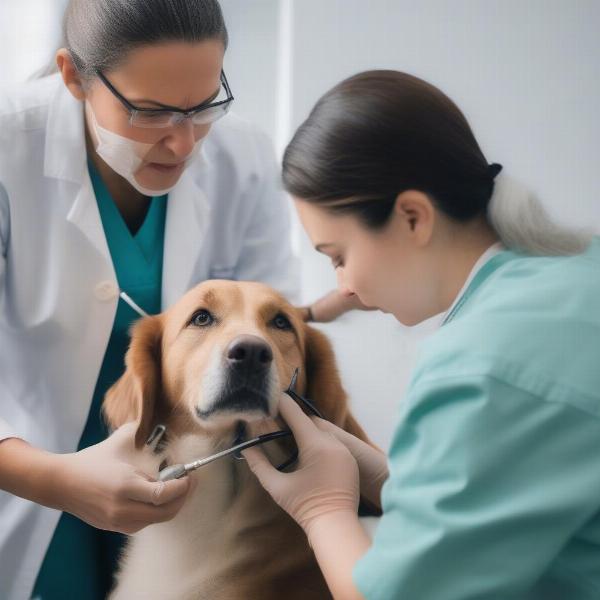Facial paralysis in dogs can be a worrying sight for any owner. Understanding the causes, symptoms, and potential dog facial paralysis recovery time is crucial for providing the best possible care. This guide will delve into all aspects of this condition, offering practical advice and insights to help you navigate this challenging time.
Understanding Facial Paralysis in Dogs
Facial paralysis, also known as facial nerve paralysis, occurs when the facial nerve, which controls facial muscles, is damaged or inflamed. This can result in drooping of the face, inability to blink, and difficulty eating or drinking. Several factors can contribute to facial paralysis, including infections, trauma, tumors, and even idiopathic causes (unknown origin).
Common Symptoms and Diagnosis
Recognizing the signs of facial paralysis is the first step towards seeking appropriate veterinary care. Common symptoms include: a drooping ear, inability to blink or close the eye on the affected side, drooling, difficulty eating or drinking, and changes in facial expression. Your veterinarian will conduct a thorough physical examination and may recommend further tests such as blood work, X-rays, or MRI to determine the underlying cause. facial palsy in dogs A proper diagnosis is essential for determining the dog facial paralysis recovery time and treatment plan.
Dog Facial Paralysis Recovery Time and Treatment Options
The dog facial paralysis recovery time varies greatly depending on the underlying cause and severity of the condition. Some cases may resolve within a few weeks with supportive care, while others may require months or even result in permanent paralysis. Treatment focuses on addressing the underlying cause, managing symptoms, and providing supportive care. Medications such as corticosteroids may be prescribed to reduce inflammation, while antibiotics may be necessary for infections. In some cases, surgery may be required to remove tumors or address trauma.  Dog Receiving Veterinary Care for Facial Paralysis
Dog Receiving Veterinary Care for Facial Paralysis
Supportive Care at Home
Providing supportive care at home is vital for your dog’s comfort and recovery. Protecting the affected eye from dryness and injury is crucial. Lubricating eye drops can prevent corneal ulcers, and you may need to manually close your dog’s eyelid periodically. Assisting with eating and drinking may also be necessary, ensuring your dog receives adequate nutrition and hydration. dog ear flushing surgery cost uk Patience and consistent care are key during this recovery period.
What to Expect During Recovery
During the recovery period, you’ll likely see gradual improvements in your dog’s facial function. The drooping may lessen, blinking may return, and your dog may regain the ability to eat and drink normally. Regular check-ups with your veterinarian are essential to monitor progress and adjust treatment as needed. facial nerve paralysis dog Even in cases of complete recovery, some residual facial asymmetry may persist.
When to Seek Immediate Veterinary Attention
If you notice any sudden changes in your dog’s facial expression, such as drooping, inability to blink, or difficulty eating, contact your veterinarian immediately. Prompt diagnosis and treatment can significantly impact the dog facial paralysis recovery time and overall prognosis.
Conclusion: A Journey of Patience and Care
Dog facial paralysis can be a challenging experience, but with proper veterinary care and dedicated home support, many dogs can recover and regain their quality of life. Understanding the dog facial paralysis recovery time, treatment options, and supportive care strategies will empower you to provide the best possible care for your furry friend throughout their recovery journey.
FAQ
- How long does it take for a dog to recover from facial paralysis? Recovery time varies, ranging from weeks to months, or even permanent paralysis in some cases.
- What are the signs of facial paralysis in dogs? Drooping ear, inability to blink, drooling, difficulty eating, and changes in facial expression.
- Can facial paralysis be cured in dogs? Treatment outcomes vary depending on the underlying cause. Some dogs recover fully, while others experience partial or no recovery.
- What is the most common cause of facial paralysis in dogs? Idiopathic (unknown cause) is often cited as the most common, followed by infections and trauma.
- How can I care for my dog’s eye if they can’t blink? Lubricating eye drops and manually closing the eyelid are essential to prevent corneal damage.
- What should I feed my dog if they have difficulty eating? Soft or moistened food can make eating easier. Consult your veterinarian for dietary recommendations.
- Will my dog’s face ever look normal again? While many dogs recover significantly, some residual facial asymmetry may persist.
About ILM Dog
ILM Dog is your trusted global resource for comprehensive dog care and wellbeing information. We offer expert advice on breed selection, health, training, nutrition, grooming, and much more. From puppyhood to senior care, we’re here to support you every step of the way. Contact us for personalized guidance or explore our extensive resources to enhance your dog’s life. Email: [email protected], Phone: +44 20-3965-8624.